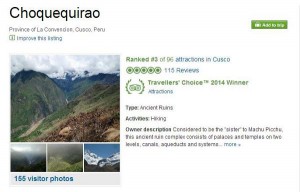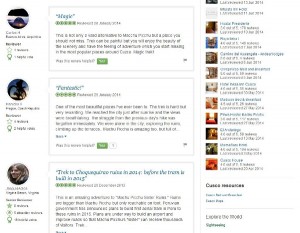How To Use TripAdvisor To
Create Enticing Travel Content

Your team has finally decided on the content for your homepage –and it’s pretty freakin’ awesome.
Maybe you’re using an image of a sky-piercing mountain against an azure sky or a photo of your palm-fringed infinity pool in all its shimmery glory. The headline is concise, witty and matches your brand oh-so-perfectly.
It took hours of debate among your colleagues to settle on this decision, but now it’s finally done. High-fives all around.
But before popping that champagne, let me ask you one little thing…
How do you know your website content will
actually engage your audience?
How do you know that the second they see that image and read the accompanying headline, they’ll get excited and want to find out more about your business? How do you know you’re using the right messages?
Well, unless you based those decisions on voice of customer data, you won’t know the answer to any of these questions. That’s why it’s important that your website content reflects the results of surveys, interviews, reviews and other input from your customers.
Why is this so crucial? Conversion copywriting guru and Copy Hackers founder Joanna Wiebe, who taught me much of what I’ll be sharing in this article, sums up the answer nicely:
“Why should you look to your customers first for messaging? Because the more you reflect what people are thinking, feeling and experiencing when they arrive on your page, the greater the likelihood that they will trust you, believe you’ve created the solution to their problems and buy from you.”
By digging into voice of customer data you can also develop a deep understanding of how your customers experience your service, property or destination. And that’s key for writing travel copy that converts.
Now, I’ve touted the benefits of surveys and interviews in past articles. But what if you’re not able to survey your customers? Or maybe, you’ve done a few surveys but you’re not happy with the number of respondents and you’d like to supplement your data?
That’s where websites like TripAdvisor come to the rescue.
Use their words (not your own)
Ok, enough chat. Let’s dive in.
Hop onto TripAdvisor and start searchin’ the most recent reviews about your business first. You’re hunting for phrases that cover things like:
[custom_list style=”list-1″]
- The natural language people use to describe your service or product
- What they love most about your business
- Sensory-focused descriptions
- Specific benefits they talk about
- The adjectives they use most often
- Memorable phrases (including similes and metaphors) that stand out
- Problems or pain points they mention (For example: “I was really stressed about going on this trek because of the wildlife in the area, but John’s tour company put my fears at ease.”)
[/custom_list]

High-converting messages are hidden within voice of customer data, including TripAdvisor reviews.
Sift through at least 20 reviews, but tackle the most recent ones first. And make sure that if you do mine any reviews older than a year that no significant changes (like renovations) have taken place at your business.
While you’re perusing the reviews, jot down notes based on the above criteria — just go ahead and copy and paste the phrases that jump out at you.
Once you’ve got a decent amount of data compiled, take a good look at it all and watch for recurring themes. What messages were repeated by travelers over and over again? The strongest 3-4 themes will help you make better decisions on what exactly you should be communicating on your website.
Use these messages to guide how you write headlines, subheads or select images for your online marketing. Use ‘em in your e-mail marketing too. If folks are expressing a similar phrase or benefit over and over again on TripAdvisor, it just might be that engaging message you’re looking for.
In fact, you should even ‘swipe’ the exact words that your customers use to describe your business and then use them — verbatim — in your website and e-mail copy.
[toggle_content title=”A Quick Example Of How I Used This Technique For A Hotel Website”]
An LA hotel hired me a while back to write copy for their new website. The looming launch date meant we didn’t have enough time to survey past customers.
So I started combing through the hotel’s reviews on TripAdvisor, always aware that they wanted to focus more heavily on the growing leisure traveler market.
I read maybe 50 reviews and kept a list of ‘swiped’ phrases based on the criteria mentioned above. Here are a few of the standouts:
It is close enough to everything yet far enough away to feel like you are outside of the city.
It seemed more like an undiscovered and exclusive enclave
A really relaxing place to get away for a long weekend.
A great vacation spot that transports you out of the Los Angeles hustle and crush. Very refreshing.
Maybe you see where I’m going with this already. This hotel has a lot going for it: it’s near the cruise ship terminal, plus it’s got plush beds and friendly staff. And although reviewers did mention this stuff, one theme was clearly dominant: this hotel was more relaxing than what many travelers were expecting. And they loved it.
So that inspired the headline: A More Relaxing Way To Experience LA
The rest of the copy also reflected the language that reviewers’ used when describing the soothing marina vibe and the nearby markets. Some of the copy for the subheads was taken verbatim from the reviews.
I wanted to give readers’ a taste of the same emotions that past guests were feeling when they stayed at this property.
[/toggle_content]
And if you’re still not convinced, check out how the folks at Copy Hackers were able to get a 103% boost in conversions by tweaking a testimonial on their client’s website.
Make sure your website jives with the reviews
But perhaps even more important than digging up these high-converting messages is ensuring that nothing on your website contradicts what folks on TripAdvisor are saying. After all, there’s a pretty big chance travelers are going to look at loads of reviews about your destination or business before booking.
Here’s the sort of thing you want to avoid: a traveler reads on your tour company website that you offer ‘luxury adventures’ and a ‘refined outdoor experience.’ But when she heads over to TripAdvisor, your prospect sees 10 reviews that describe something totally different.
Past customers say your tours are ‘rugged’, ‘challenging’ and ‘a no-frills wilderness expedition.’ Sure, there’s nothing wrong with those sort of reviews (hell, it sounds like my kind of trip). But it’s not what your website says.
Your prospect is now getting two different stories – and she’s starting to wonder whether any of the information on your website is trustworthy.
Now, that’s an extreme example. But these type of problems can hurt you on a smaller scale, like saying your beds are ‘plush and luxurious’ when everyone on TripAdvisor says they’re a little too hard. Or calling your breakfast ‘hearty’ (and please never use the cliché ‘hearty’) when folks have said they wished the servings were bigger.
I’m certainly not suggesting that travel operators are trying to deceive people. It’s actually quite difficult to look at your product or destination objectively when you’re so close to it. So instead, dive into your voice of customer data (like reviews and surveys) and find out exactly how others experience your business.
Go beyond TripAdvisor for data
I focused on TripAdvisor in this article because it’s by far the largest source of user-generated voice of customer data available for the travel industry. But there are plenty of other places to mine messages.
And the sources you mine don’t have to be specifically about your business – they just have to be created by the customers you want. Focus on the benefits travelers want most from your type of product, service or destination.
Give these a shot:
[custom_list style=”list-1″]
- Traveler testimonials
- Travel forums
- Social media
- Others reviews sources, like OTAs
- E-mails from customers
- Amazon book reviews (read this article for more on that)
[/custom_list]
Lots of material there. So forget about what
you want to say, and focus on what your best prospects need to hear. Do that and your travel content will really start converting.
— Dustin Walker
Fire Up Your Marketing Content
Get blog articles on how to create compelling travel content that’ll boost your traffic, leads and bookings. Just enter your best e-mail address in the box below…


